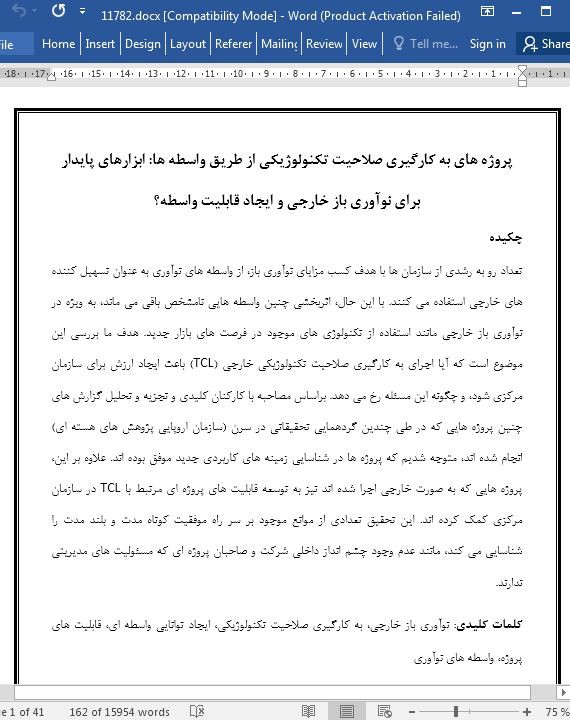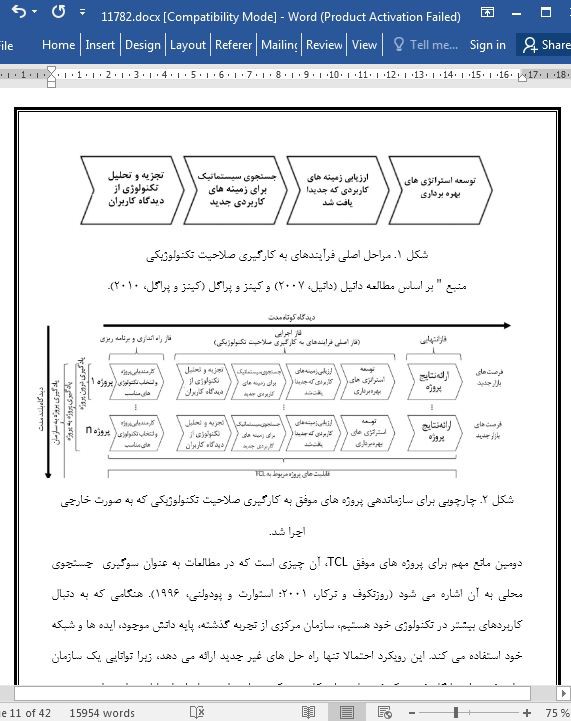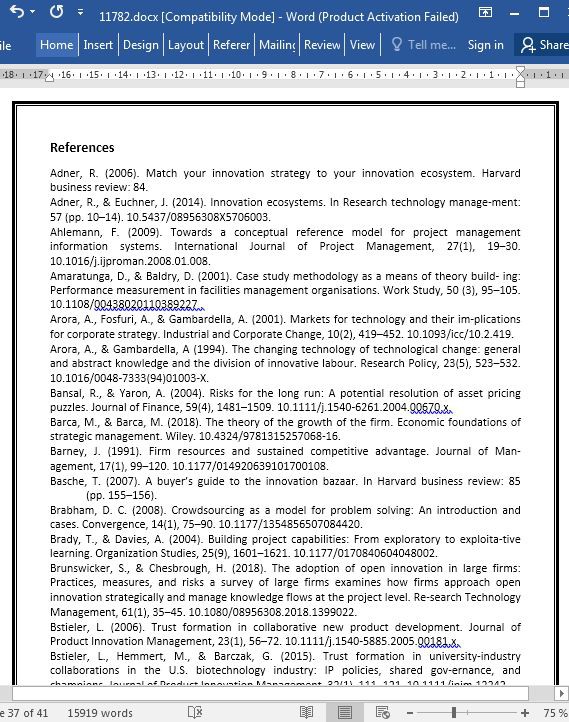
پروژه های به کارگیری صلاحیت تکنولوژیکی از طریق واسطه ها
چکیده
تعداد رو به رشدی از سازمان ها با هدف کسب مزایای نوآوری باز، از واسطه های نوآوری به عنوان تسهیل کننده های خارجی استفاده می کنند. با این حال، اثربخشی چنین واسطه هایی نامشخص باقی می ماند، به ویژه در نوآوری باز خارجی مانند استفاده از تکنولوژی های موجود در فرصت های بازار جدید. هدف ما بررسی این موضوع است که آیا اجرای به کارگیری صلاحیت تکنولوژیکی خارجی (TCL) باعث ایجاد ارزش برای سازمان مرکزی شود، و چگونه این مسئله رخ می دهد. براساس مصاحبه با کارکنان کلیدی و تجزیه و تحلیل گزارش های چنین پروژه هایی که در طی چندین گردهمایی تحقیقاتی در سرن (سازمان اروپایی پژوهش های هسته ای) انجام شده اند، متوجه شدیم که پروژه ها در شناسایی زمینه های کاربردی جدید موفق بوده اند. علاوه بر این، پروژه هایی که به صورت خارجی اجرا شده اند نیز به توسعه قابلیت های پروژه ای مرتبط با TCL در سازمان مرکزی کمک کرده اند. این تحقیق تعدادی از موانع موجود بر سر راه موفقیت کوتاه مدت و بلند مدت را شناسایی می کند، مانند عدم وجود چشم انداز داخلی شرکت و صاحبان پروژه ای که مسئولیت های مدیریتی ندارند.
مقدمه
نوآوری باز یک رویکرد نسبتا جدید است و در حال حاضر در زمینه مدیریت نوآوری کاملا شناخته شده می باشد. این مفهوم بیانگر ایده استفاده از " … جریان های ورودی و خروجی هدفمند دانش برای شتاب بخشیدن به نوآوری داخلی و گسترش بازارها برای استفاده خارجی از نوآوری است (وست، ونهاوربکه و چسبرو، 2006). مزایای بالقوه نوآوری باز به طور گسترده مورد مطالعه قرار گرفته است: از یک سو فعالیت های نوآوری باز ممکن است به ایجاد جریان های درآمدی جدید یا افزایش جریان های درآمدی موجود کمک کند. این جریان ها را می توان به روش های مختلفی به دست آورد، به عنوان مثال با تجاری سازی خارجی دانش داخلی (آرورا، فسفوری و گامباردلا، 2001 ؛ دک، 2008) و یا منبع یابی دانش خارجی برای استفاده از آن در توسعه محصولاتی که اساسا جدید هستند (فرانکه، وون هیپل و شریر، 2006 ؛ لیلیان، موریسون، سیرلز، سانناک و وون هیپل، 2002) یا به طور ویژه در راستای اولویت های کاربران قرار دارند (فرانکه، کینز و استگر، 2009). از سوی دیگر نوآوری باز ممکن است به کاهش زمان و پول صرف شده در طول فرایندهای تحقیق و توسعه (R&D) کمک کند، به عنوان مثال با استفاده از پتانسیل خلاق و نیروی کار فعالان خارجی (برابهام، 2008 ؛ نیوتن و همکاران، 2010) و یا کاهش تعداد حلقه های آزمون و خطا با کاربران لازم برای آزمایش ایده های محصول جدید (وون هیپل، 2005؛ وون هیپل و کاتز، 2002).
محدودیت ها و تحقیقات بیشتر
این مطالعه موردی نیز همانند هر تحقیق تجربی دیگر، دارای برخی محدودیت های روش شناختی خاص است. با این حال، تحقیق ما یک پدیده گسترده و مهم در زمینه بسیار محدود سازمان های تحقیقاتی را در مقیاس بزرگ مورد بررسی قرار داده است. بنابراین، برخی از بینش ها بسیار خاص هستند و ممکن است به راحتی قابل تعمیم نباشند. به عنوان مثال در خارج از حوزه تحقیق ممکن است الگوی ۸ (صاحبان پروژه بدون مسئولیت مدیریت) به طور مکرر رخ ندهد. در بسیاری از شرکت ها، پروژه های TCL به احتمال زیاد دارای کارکنانی به عنوان توسعه دهندگان کسب وکار خواهند بود که معمولا دارای مسئولیت های مدیریتی هستند. علاوه بر این، شناسایی و به دست آوردن همکاران بالقوه ممکن است بیشتر از شرکت ها برای سازمان های تحقیقاتی بزرگ مشکل باشد. تحقیقات آینده ممکن است بخواهند بررسی کنند که آیا الگوهای شناسایی شده در این مطالعه موردی، برای زمینه های دیگر نیز درست هستند یا خیر.
Abstract
Aiming at reaping the benefits of open innovation, a growing number of organizations utilizes innovation intermediaries as external facilitators. However, the effectiveness of such intermediaries, especially in outbound open innovation, such as leveraging existing technologies in new market opportunities, remains unclear. We aim to investigate if and how externally conducted technological competence leveraging (TCL) projects provide value to the focal organization. Based on interviews with key personnel and analysis of reports from such projects conducted in the course of several research consortia at CERN, the European Organization for Nuclear Research, we find that the projects were successful in identifying new application fields. Further, the externally conducted projects also contributed to the development of TCL-related project capabilities within the focal organization. This research also identifies a number of barriers to short- and long-term success such as lack of a company-internal perspective and project owners without management responsibilities.
Introduction
Open innovation is a relatively new and nowadays widely recognized approach to innovation management. It denotes the idea to use “…purposive inflows and outflows of knowledge to accelerate internal innovation, and expand the markets for external use of innovation, respectively” (West, Vanhaverbeke & Chesbrough, 2006). The potential merits of open innovation have been studied quite extensively: One the one hand, open innovation activities may contribute to generating new or increasing existing revenue streams. This can be achieved in different ways, e.g., by externally commercializing internal knowledge (Arora, Fosfuri & Gambardella, 2001; Deck, 2008) and/or sourcing external knowledge to utilize it in the development of products that are radically new (Franke, Von Hippel & Schreier, 2006; Lilien, Morrison, Searls, Sonnack & Von Hippel, 2002) or particularly well in line with the users’ preferences (Franke, Keinz & Steger, 2009). On the other hand, open innovation might help to cut down time and money spent during R&D processes, e.g., by leveraging the creative potential and workforce of external actors (Brabham, 2008; Newton et al., 2010) and/or reducing the number of trial-and-error loops with users necessary to test new product ideas (von Hippel, 2005; Von Hippel & Katz, 2002).
Limitations and further research
As any empirical research, this case study suffers from some specific, methodological limitations. Our research investigated a broad and important phenomenon, however, in the very narrow context of large-scale research organizations. Thus, some of the insights are very specific and might not be easily generalized. For example, Pattern 8 (project owners without management responsibility) might not occur quite frequently outside of the research domain. In many companies, TCL projects will be very likely staffed with business developers that usually do have managerial responsibilities. Further, the identification and acquisition of potential collaborators might be much more of a problem to large research organizations than companies. Future research might want to look into whether or not the patterns identified in this case study hold true for other contexts as well.
چکیده
مقدمه
مرور و چارچوب ادبیات
یک دیدگاه قابلیتی در مورد به کارگیری صلاحیت تکنولوژیکی
سازمان فعالیت های به کارگیر صلاحیت تکنولوژیکی
به سوی یک چارچوب یکپارچه برای ارزیابی موفقیت پروژه های TCL که به صورت خارجی هدایت می شوند
تحلیل مزایای کوتاه مدت پروژه های TCL که به صورت خارجی اجرا شده
تحلیل مزایای بلند مدت پروژه های TCL که به صورت خارجی اجرا شده
روش
رویکرد تحقیق
جمع آوری داده ها
تجزیه و تحلیل داده ها
نتایج
نتایج کوتاه مدت پروژه
نتایج پروژه بلند مدت
موانع نتایج کوتاه مدت پروژه
موانع موفقیت بلند مدت
بحث
مشارکت های نظری
مشارکت های مدیریتی
محدودیت ها و تحقیقات بیشتر
ضمیمه
پرسشنامه
منابع
Abstract
Introduction
Literature review and framework
A capability view on technological competence leveraging
The organization of technological competence leveraging activities
Towards an integrated framework for assessing the success of externally conducted TCL projects
Method
Research approach
Data collection
Data analysis
Results
Short-term project outcomes
Long-term project outcomes
Barriers to short-term project outcomes
Barriers to long-term success
Discussion
Theoretical contributions
Managerial contributions
Limitations and further research
Declaration of Competing Interest
Acknowledgments
Appendix
References
- اصل مقاله انگلیسی با فرمت ورد (word) با قابلیت ویرایش
- ترجمه فارسی مقاله با فرمت ورد (word) با قابلیت ویرایش، بدون آرم سایت ای ترجمه
- ترجمه فارسی مقاله با فرمت pdf، بدون آرم سایت ای ترجمه



